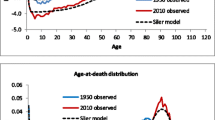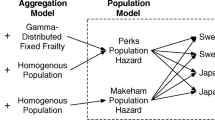Abstract
In developed countries, mortality decline is decelerating at younger ages and accelerating at old ages, a phenomenon we call “rotation.” We expect that this rotation will also occur in developing countries as they attain high life expectancies. But the rotation is subtle and has proved difficult to handle in mortality models that include all age groups. Without taking it into account, however, long-term mortality projections will produce questionable results. We simplify the problem by focusing on the relative magnitude of death rates at two ages (0 and 15–19) while making assumptions about changes in rates of decline at other ages. We extend the Lee-Carter method to incorporate this subtle rotation in projection. We suggest that the extended Lee-Carter method could provide plausible projections of the age pattern of mortality for populations, including those that currently have very high life expectancies. Detailed examples are given using data from Japan and the United States.










Similar content being viewed by others
Notes
In this article, period 2005–2010 is simplified as 2008, which is a rounding up of the midpoint, 2007.5; and years ending with 3 and 8 are used to represent the corresponding five-year periods.
Death rates of abridged life tables in five-year period were obtained on December 2011 from National Statistic Offices and the University of California at Berkeley and the Max Planck Institute for Demographic Research (2012). These death rates are computed from the five-year-period deaths and exposures. The use of five-year period data is more parsimonious and allows us to compute more robust b(x) distributions, even for smaller populations.
There are two ways to compute the total person-years in the open age group, the first assuming that the population in this age group is stationary and the second assuming the death rate in this age group obeys a logistic model converging to 1. The HMD used the second, and we also use it to extend the age group to 130 years, at which death rates are close to 1.
References
Bongaarts, J. (2005). Long-range trends in adult mortality: Models and projection methods. Demography, 42, 23–49.
Booth, H. (2006). Demographic forecasting: 1980 to 2005 in review. International Journal of Forecasting, 22, 547–581.
Chu, C. Y. C., Chien, H.-K., & Lee, R. D. (2008). Explaining the optimality of U-shaped age-specific mortality. Theoretical Population Biology, 73, 171–180.
Fisher, R. A. (1930). The genetical theory of natural selection. Oxford, UK: The Clarendon press.
Galley, C., & Woods, R. (1999). On the distribution of deaths during the first year of life. Population: An English Selection, 11, 35–59.
Girosi, F., & King, G. (2008). Demographic forecasting. Princeton: Princeton University Press.
Hamilton, W. D. (1966). The moulding of senescence by natural selection. Journal of Theoretical Biology, 12, 12–45.
Horiuchi, S., & Wilmoth, J. R. (1995, April). The aging of mortality decline. Paper presented at the annual meeting of the Population Association of America, San Francisco, CA.
Kannisto, V., Lauritsen, J., Thatcher, A. R., & Vaupel, J. W. (1994). Reductions in mortality at advanced ages: Several decades of evidence from 27 countries. Population and Development Review, 20, 793–810.
Lee, R. (2000). The Lee-Carter method for forecasting mortality, with various extensions and applications. North American Actuarial Journal, 4, 80–93.
Lee, R. D. (2003). Rethinking the evolutionary theory of aging—Transfers, not births, shape senescence in social species. Proceedings of the National Academy of Sciences, 100, 9637–9642.
Lee, R. (2008). Sociality, selection, and survival: Simulated evolution of mortality with intergenerational transfers and food sharing. Proceedings of the National Academy of Sciences, 105, 7124–7128.
Lee, R. D., & Carter, L. R. (1992). Modeling and forecasting U.S. mortality. Journal of the American Statistical Association, 87, 659–671.
Lee, R., & Miller, T. (2001). Evaluating the performance of the Lee-Carter method for forecasting mortality. Demography, 38, 537–549.
Li, N., & Gerland, P. (2011, April). Modifying the Lee-Carter method to project mortality changes up to 2100. Paper presented at the annual meeting of the Population Association of America, Washington, DC.
Li, N., & Lee, R. (2005). Coherent mortality forecasts for a group of populations: An extension of the Lee-Carter method. Demography, 42, 575–594.
Liu, L., Johnson, H. L., Cousens, S., Perin, J., Scott, S., Lawn, J. E., . . . Black, R. E. (2012). Global, regional, and national causes of child mortality: An updated systematic analysis for 2010 with time trends since 2000. Lancet, 379, 2151–2161.
Patton, G. C., Coffey, C., Sawyer, S. M., Viner, R. M., Haller, D. M., Bose, K., . . . Mathers, C. D. (2009). Global patterns of mortality in young people: a systematic analysis of population health data. Lancet, 374, 881–892. doi:10.1016/S0140-6736(09)60741-8
Raftery, A., Chunn, J., Gerland, P., & Ševčíková, H. (2013). Bayesian probabilistic projections of life expectancy for all countries. Demography, 50, 77–801.
Rao, C., Adair, T., & Kinfu, Y. (2011). Using historical vital statistics to predict the distribution of under-five mortality by cause. Clinical Medicine & Research, 9, 66–74.
Shang, H. L., Booth, H., & Hyndman, R. (2011). Point and interval forecasts of mortality rates and life expectancy: A comparison of ten principal component methods. Demographic Research, 25(article 5), 173–214. doi:10.4054/DemRes.2011.25.5
Soneji, S., & King, G. (2011). The future of death in America. Demographic Research, 25(article 1), 1–38. doi:10.4054/DemRes.2011.25.1
Tuljapurkar, S., Li, N., & Boe, C. (2000). A universal pattern of mortality decline in the G7 countries. Nature, 405, 789–792.
United Nations. (2010). World population prospects: The 2006 revision, volume III: Analytical report. New York: Department of Economic and Social Affairs, Population Division.
University of California at Berkeley & Max Planck Institute for Demographic Research. (2012). Human Mortality Database (HMD). Retrieved from www.mortality.org or www.humanmortality.de
Acknowledgement and disclaimer
The authors thank Shripad Tuljapurkar and Carl Boe for their useful comments. The views expressed in this article are those of the authors and do not necessarily reflect those of the United Nations.
Author information
Authors and Affiliations
Corresponding author
Rights and permissions
About this article
Cite this article
Li, N., Lee, R. & Gerland, P. Extending the Lee-Carter Method to Model the Rotation of Age Patterns of Mortality Decline for Long-Term Projections. Demography 50, 2037–2051 (2013). https://doi.org/10.1007/s13524-013-0232-2
Published:
Issue Date:
DOI: https://doi.org/10.1007/s13524-013-0232-2




